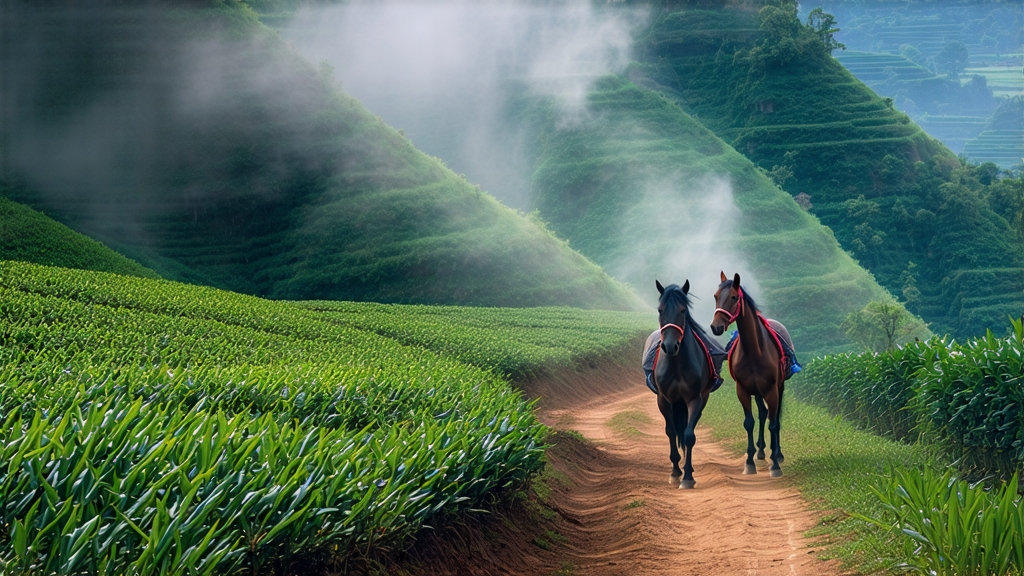
Liu Bao—pronounced “lee-ow bao”—is the quietest celebrity in China’s dark-tea family. While Pu-erh hoards the limelight, Liu Bao has spent four centuries maturing in clay jars, sailing on bamboo rafts down the Liu River, and mellowing in the humid storerooms of Guangxi Province. To meet it is to taste a chapter of maritime Silk-Road history that never quite made the textbooks.
History: From Border Tribute to Sailor’s Secret
The name simply means “sixth fortress,” a nod to the old trading post where bales of tea were weighed and taxed during the Qing dynasty. By 1680 the tea was already listed as “tribute” in imperial ledgers, yet its real fame came when dockworkers in Guangzhou discovered that a cask of Liu Bao, accidentally soaked in bilge water, emerged rounder, sweeter, and oddly more alive. Merchants began aging it on purpose, stacking leaf inside the dank holds of junks bound for Southeast Asia. In Malacca, Penang, and Jakarta the tea became a currency of coolies and clansmen; grandmothers steeped it with ginger to cure “ship fever,” and tin-mines served it thick and sugary to laborers who trusted its ability to “cut the grease” of a 14-hour day. When the Suez Canal opened, Liu Bao rode the same waves as opium and porcelain, only to vanish behind the Iron Curtain for most of the twentieth century. Today the vintage bricks that surface in Kuala Lumpur pawn shops carry postage-stamp labels of the state-run Wuzhou Tea Factory, their wrappers brittle as autumn locust wings, their value doubling every time another Singapore uncle remembers the taste of childhood.
Terroir and Leaf: Subtropical Vertigo
Guangxi’s climate is a giant fermentation chamber: 80 % humidity, acid red latosol soil, and a diurnal swing gentle enough to keep tea leaves awake but not anxious. The indigenous large-leaf variety, Camellia sinensis var. sinensis f. pubilimba, grows between 200–600 m along the limestone karsts of the Da Yao Mountains. The leaves are broader than Yunnan’s, yet thinner, carrying a higher ratio of stem—those hollow twigs act as straws conducting humidity and later providing airy channels through which beneficial molds can breathe.
Craft: The 48-Day Whisper
Picking follows the southern Chinese arc: one bud, three or four leaves, plucked from Qingming to Guyu (early April to late May). After a brief outdoor withering the leaves are wok-fired at 280 °C for eight minutes, hot enough to kill green enzymes but leave a turquoise core. The twist comes next: rolling is done in a rattan-lined trough where barefoot tea masters perform a slow waltz—heel, ball, toe—coaxing cell sap to the surface without bruising the vein. Sun-drying lasts only 40 minutes; clouds race too fast for prolonged exposure, so the leaf is still limp when it enters the “wet piling” stage, the moment Liu Bao becomes dark tea.
Wet-piling (wo dui) in Wuzhou is gentler than the Yunnan version. Leaves are piled 70 cm high, misted with Liu River water, then covered with jute and giant banana leaves. Every four days the pile is turned by shovel, yet the core temperature is never allowed above 55 °C; the goal is microbial dialogue, not domination. After six weeks the leaf emerges chocolate-brown, smelling of damp nutmeg and betel-nut husk. It is then steamed, pressed into 50 kg wicker baskets lined with bamboo skin, and transferred to government-controlled humid warehouses where it will rest for a minimum of three years before the first sale. Only time earns the right to print the Liu Bao name on the wrapper.
Grades and Shapes
Unlike Pu-erh’s mountain-village chaos, Liu Bao is officially graded 1 through 6 plus Special Grade, determined by leaf size and stem ratio. Grade 1 is all buds, golden and rare; Grade 6 is mostly stems, beloved by dockworkers for its affordability and sweet aftertaste. Traditional packing shapes include:
- Basket Tea (luo cha): 40–50 kg pressed into a cylinder hand-bound with thin rattan bands.
- Brick (zhuan cha): 2 kg rectangle, easy to stack in ship hulls.
- Coin (yuan cha): 7 g disc, pier